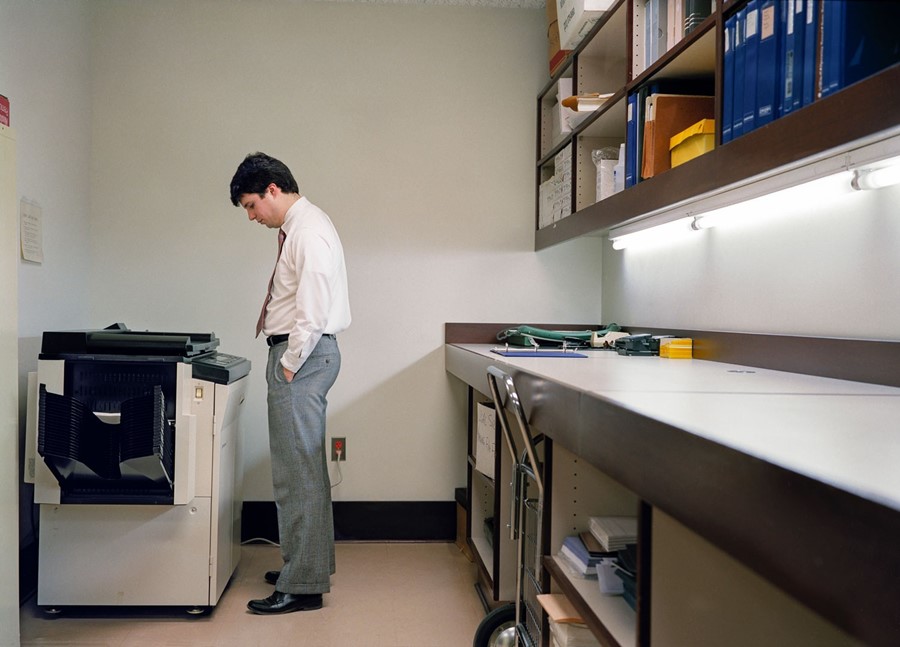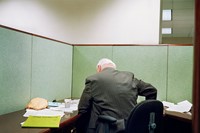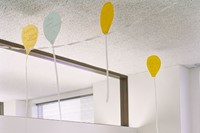The photographer discusses his new book, which takes inspiration from Edward Hopper’s 1940 painting, Office at Night
Now that we’re “living with Covid”, politicians and business owners alike are calling for the resurgence of office life. Convinced people perform better inside a shared space replete with beige walls, industrial carpeting, and modular furniture, the mainstream media has been churning out endless screeds about the benefits of “office culture” on worker productivity – despite evidence to the contrary.
With the recent publication of The Office (Hoxton Mini Press), photographer Steven Ahlgren captures the quiet drama and mundane magic of office life with a distinctive sense of ambiguity. Photographing inside American offices during the 1990s and 2000s, Ahlgren sees beauty in the everyday, quotidian moments of life.
Ahlgren began the series as an extension of his own life. While working in a Minneapolis bank in 1987, he began making frequent trips to look at Edward Hooper’s 1940 painting, Office at Night at the Walker Art Center. In the scene, a man sits at his desk reading a document while his secretary stands behind him, ostensibly filing papers, while lost in her own thoughts. Although quiet and calm, an air of melancholy persists. The day is over, yet they have not left.
“I had been working in an office since 1984 and I was growing a little disenchanted with it,” Ahlgren says. “I was struck by the Hopper painting – oh my gosh, look at this. Here’s a scene in an office where I am every day that seems so pedestrian. I kept coming back to it because, like so many of his paintings, it lets you make up your own story. I was trying to figure it out but I never really resolved in my mind what was happening there.”
At the same time, Ahlgren was becoming more involved in photography and eventually left the bank – but the office kept calling him back. The hardest part was securing permission; but once he was in, Ahlgren was ready to create his own ambiguous narratives that leave space for the viewers, just as Hopper did.
“One of the first pictures I made in the series was a guy making photocopies,” Ahlgren says. “I was in the coffee room when the guy came in. He was there for a while making copies, and when I saw this scene – it was as close to a self-portrait as I had ever made because surely I had looked exactly like that when I was at the bank, lost in my thoughts and wondering how long was I going to stay there? What was I going to do?”
Ahlgren points to another photograph made in a bank, where two women are sitting in a boardroom surrounded by men – actual men at the conference table and men in portraits hung in row after row on the wall being them. For Ahlgren, the photograph speaks to what the women in his family experience working in male-dominated industries.
“My wife works in a law firm and she has to deal with a culture that’s heavily like that,” he says. “My older daughter is a mechanical engineering student and she’s sometimes one of the only women in the room. It resonates with me because I’ve never had that situation of being the only man in the room – except when my daughters were born and I was the stay-at-home parents. I was the only father in the playgroup.”
Looking at the photograph of the man sitting at his desk, surrounded by “birthday balloons,” Ahlgren notes that while some see the image as tragic and sad, he finds it touching and thoughtful. “They made this with stuff that was available to celebrate his birthday. It was a heartfelt gesture,” he says. “A lot of it is what you bring to the pictures yourself.”
The Office by Steven Ahlgren is published by Hoxton Mini Press, and is out now.






